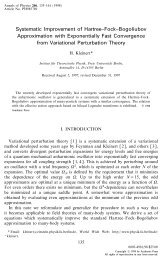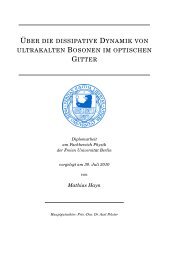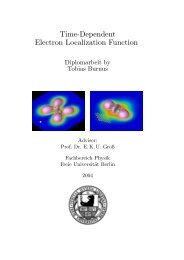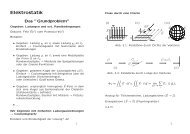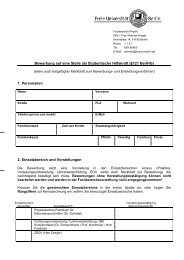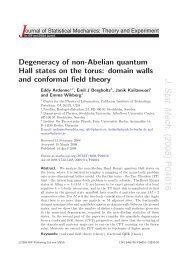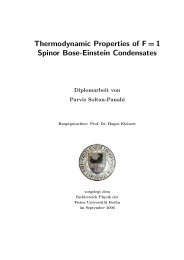Diploma thesis
Diploma thesis
Diploma thesis
You also want an ePaper? Increase the reach of your titles
YUMPU automatically turns print PDFs into web optimized ePapers that Google loves.
4 Complex harmonic potential<br />
4.1.1 Symmetric states<br />
With (4.22) the continuity condition ψ s 1(−w) = ψ s 2(−w) provides<br />
[ (<br />
A s 1e − 1 2 ω2 1F 1 a 1 ; 1 )<br />
2 ; ω2 − 2ω Γ ( )<br />
a 1 + 1 2<br />
Γ (a 1 )<br />
1F 1<br />
(<br />
a 1 + 1 2 ; 3 2 ; ω2 ) ] = A s 2e − 1 2 θω2 1F 1<br />
(<br />
a 2 ; 1 2 ; θω2 )<br />
. (4.33)<br />
With this we reexpress A s 2 in terms of A s 1, which then exhibits the normalization constant of the<br />
whole symmetric wave function, so that we call it from now on N s := A s 1. Then the continuity<br />
condition reads<br />
A s 2 = N s e 1 2 (θ−1)ω2 1 F 1<br />
(<br />
a1 ; 1 2 ; ω2) − 2ω Γ(a 1+ 1 2)<br />
Γ(a 1 ) 1F 1<br />
(<br />
a1 + 1 2 ; 3 2 ; ω2)<br />
1F 1<br />
(<br />
a2 ; 1 2 ; θω2 ) =: N s R s , (4.34)<br />
where R s = R s (ω, ε, c) represents an abbreviation. We can now write down the wave functions in<br />
all 3 areas obeying (4.14), which yields the symmetric wave function ψ s :<br />
[ (<br />
e<br />
⎧⎪ − 1 2 χ2 1F 1 a1 ; 1; 2 χ2) + 2χ Γ(a 1+ 1 (<br />
2)<br />
Γ(a 1 ) 1F 1 a1 + 1; 3; 2 2 χ2)] , χ < −ω<br />
⎨ (<br />
ψ s (χ) = N s R s e − 1 2 θχ2 1F 1 a2 ; 1; 2 θχ2)<br />
, −ω ≤ χ ≤ ω<br />
⎪ ⎩<br />
. (4.35)<br />
e − 1 2 χ2 [<br />
1F 1<br />
(<br />
a1 ; 1 2 ; χ2) − 2χ Γ(a 1+ 1 2)<br />
Γ(a 1 ) 1F 1<br />
(<br />
a1 + 1 2 ; 3 2 ; χ2)] , χ > ω<br />
4.1.1.1 Quantization condition<br />
Now we have to ensure the continuity of the first derivative of ψ s at χ = −ω<br />
d<br />
dχ ψs 1 (χ)<br />
=<br />
∣ χ=−ω<br />
d<br />
dχ ψs 2 (χ)<br />
, (4.36)<br />
∣ χ=−ω<br />
which yields with (4.35)<br />
(<br />
ω 1 F 1 a 1 ; 1 )<br />
(<br />
2 ; ω2 − 4a 1 ω 1 F 1 a 1 + 1; 3 )<br />
2 ; ω2 +<br />
2 Γ ( )<br />
a 1 + 1 [<br />
2 (1<br />
− ω<br />
2 ) 1F 1<br />
(a 1 + 1 Γ (a 1 )<br />
2 ; 3 )<br />
2 ; ω2 + 4 (<br />
a 1 + 1 )<br />
ω 2 1F 1<br />
(a 1 + 3 3 2<br />
2 ; 5 )]<br />
2 ; ω2<br />
(<br />
= 1 F 1 a1 ; 1 2 ; ω2) − 2ω Γ(a1+ 1 2) (<br />
Γ(a 1) 1F 1 a1 + 1 2 ; 3 2 ; ω2) [ (<br />
(<br />
1F 1 a2 ; 1 2 ; θω2) θω 1 F 1 a 2 ; 1 )<br />
(<br />
2 ; θω2 − 4a 2 θω 1 F 1 a 2 +1; 3 )]<br />
2 ; θω2 . (4.37)<br />
Here we used the derivative of the confluent hypergeometric functions with respect to the last<br />
argument<br />
40




